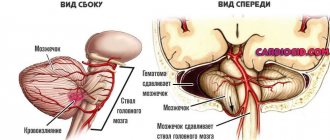Pituitary microadenoma is a small neoplasm that forms on the internal tissues of the organ. The size of this type of benign tumor does not exceed one centimeter. Since the compaction has virtually no effect on a person’s well-being, it is difficult to diagnose. In cases where it affects the production of hormones, characteristic symptoms are present.
Since the compaction practically does not manifest itself at all, it is difficult to diagnose.
What is a pituitary microadenoma?
The pituitary gland is an endocrine gland that is located at the base of the brain. The organ is responsible for human growth, metabolism and development.
The pituitary gland is located at the base of the brain.
In most cases, cystic formation affects women of reproductive age. Doctors believe that this is facilitated by changes in hormonal levels during pregnancy and breastfeeding. Certain areas of the pituitary gland are modified due to the production of large amounts of hormones (for example, prolactin). This provokes deformation of the gland tissue.
Problems usually occur in the adenohypophysis (the anterior part of the organ), but can relate to the right or left half. Although the neoplasm itself does not produce hormones, it affects their excess or decreased production. As a result, symptoms characteristic of hormonal imbalance occur. The size of the tumor does not exceed 1 cm.
The concept of pathology and its types
A pituitary tumor is a neoplasm that affects the tissues of this organ. A lesion is formed due to abnormal growth of pathological cells. As a result, hormone imbalance occurs in the body, which leads to many adverse effects.
The tumor process in the pituitary gland can be of different types. Doctors distinguish two main types of pathology:
- Functional. Such tumors contribute to changes in hormonal balance. Symptoms vary depending on which hormone is missing in the body.
- Non-functional. Neoplasms of this type are distinguished by their ability to grow large. When they reach a large size, they exert strong pressure on the parts of the brain located nearby. But at the same time, the pathology may not manifest itself for a long time.
By their nature, there are benign and malignant pituitary tumors. The first group has a favorable course. Such formations grow slowly, put pressure on nearby tissues and organs, but do not grow into them.
Malignant lesions are characterized by rapid growth, in later stages they grow into neighboring organs and give metastases throughout the body. Such neoplasms are difficult to treat and often recur.
Causes
One of the main causes of microadenoma of the pituitary gland of the brain is a change in hormonal levels. Most often this happens during pregnancy and breastfeeding. In addition, the following reasons can provoke deformation of gland tissue:
Use of oral contraceptives.
- disruptions in the activity of an internal organ associated with the hypothalamus;
- the hormonal function of the peripheral glands decreases, which provokes increased tissue growth and the appearance of compaction;
- hereditary factor;
- artificial termination of pregnancy and other surgical interventions in the pelvic organs;
- use of oral hormonal contraception;
- mechanical shocks, injuries that affect the nervous system;
- infectious processes in the brain;
- bad habits of a woman during pregnancy, as well as the ingestion of toxic substances into the body. This negatively affects the development of the embryo.
Causes of pituitary tumors
It is not always possible to identify the exact cause of the development of pituitary tumors, but possible causes include any hormonal imbalance in the body. There is a theory that the risk of developing a tumor increases with hereditary pathologies, for example, multiple endocrine neoplasia type 1. With the same pathology, the risk of tumor formation in other glands of the body increases.
A pituitary tumor in women can appear during pregnancy or after childbirth due to hormonal changes and other negative factors affecting a weakened body.
For other endocrine diseases, hormonal medications are required. Some of them can cause the formation of tumors in the pituitary gland, especially with long-term use. Chronic inflammatory processes occurring in the head area can cause cell degeneration or rapid division. These include sinusitis, sinusitis, acoustic neuroma and other infectious and inflammatory pathologies.
Other possible causes of pituitary tumors:
- head injuries – blows, skull fractures;
- cerebral edema;
- intracranial hemorrhages;
- prolonged stress, nervous shock;
- neuroinfections – most often meningitis.
There is also an assumption that the pathological division of pituitary cells is caused by dysfunction of the peripheral glands of the endocrine system, mutations of pituitary cells and excessive release of hormones in the hypothalamus.
Signs
The symptoms of a pituitary microadenoma depend on whether it affects the hormonal balance in the body. Signs will be different in men and women due to the characteristics of endocrine activity.
If the lump is hormonally inactive, it is difficult to diagnose. There are no changes in the endocrine system, so a small tumor does not cause characteristic symptoms. Hormonally active neoplasms provoke serious changes due to hormonal imbalance.
Common symptoms in women include:
Gaining excess weight.
- gaining excess weight;
- the appearance of breast milk even in the absence of lactation;
- inability to become pregnant due to suppression of ovarian activity;
- disruptions of the menstrual cycle.
In males, the increased secretion of prolactin is not so obvious, although the symptoms will be similar. Men usually don't take their own weight so seriously, so they may ignore increasing it. There are also problems with potency.
If the adenoma is located on tissues that are responsible for the production of thyroid-stimulating hormone, then the symptoms will be different. Patients note the occurrence of nodular goiter on the thyroid gland, sudden weight loss, mood swings, tachycardia and other cardiac disorders.
Heart disorders.
With increased production of growth hormone, excessive growth of all tissues occurs. In children, this manifests itself in gigantism, disturbances in the functioning of internal organs (gastrointestinal tract, lungs, internal genital organs, etc.). If an adult has a microadenoma of this type, a disproportionate increase in the size of individual parts of the body is noted. The voice becomes rougher, diabetes insipidus occurs, and there is an increased risk of developing cancer.
Common symptoms include diabetes.
The next type of compaction (corticotropic microadenoma) affects the adrenal glands, causing an increase in their work. This manifests itself in increased body weight. However, weight gain occurs unevenly. Fat is deposited mainly in the neck, abdomen, and thighs. Stretch marks occur due to a rapid increase in mass, and there is more hair on the body (this is especially noticeable in women). Common symptoms include diabetes and mental disorders.
If the tumor contributes to the excessive production of gonadotropic hormones, then it causes sexual dysfunction. This leads to infertility, impotence, and a high risk of malignant neoplasms.
As the size of the microadenoma increases, the symptoms will worsen. In addition to hormonal disorders, migraines, dizziness and loss of consciousness, and blurred vision will appear.
Surgery.
Transsphenoidal surgical removal of pituitary microadenomas is a safe treatment method that normalizes hormone secretion. This is observed already within the first day in 75% of patients with Cushing's disease caused by a pituitary microadenoma, acromegaly with a GH concentration of less than 40 ng/ml and microprolactinomas with a serum prolactin concentration of less than 200 ng/ml. According to various clinics, the initial effectiveness of such an operation ranges from 50 to 95%. Unfortunately, after an initial decrease in prolactin levels, hyperprolactinemia is restored in approximately 17% of patients over the next 3-5 years, and after 5-10 years - in almost 50% of patients. Recurrence rates after surgery for acromegaly and Cushing's disease are less well defined.
The mortality rate for transsphenoidal operations for pituitary microadenomas is 0.27%, and complications occur in approximately 1.7% of cases (based on the results of 2600 operations). Most complications are characterized by leakage of cerebrospinal fluid through the nose, paralysis of the oculomotor nerves, and loss of vision.
For large secreting tumors, surgery on the pituitary gland is less effective. In patients with serum prolactin levels above 200 ng/ml or GH levels above 40 ng/ml, hormone concentrations normalize after surgery in only 30% of cases. The operation is effective in approximately 60% of patients with Cushing's disease caused by a corticotropic macroadenoma. The relapse rate for such macroadenomas after surgical remission is unknown: in the case of prolactin-secreting tumors, the relapse rate for hyperprolactinemia is 10-80%.
The effects of the mass of large tumors are also difficult to eliminate with surgical treatment alone. In cases where surgery was the only treatment, symptoms of the disease returned within a 10-year period in 85% of patients. When surgery was combined with radiation therapy, the relapse rate over 10 years was 15%.
Mortality during operations for macroadenomas is about 0.86%, and complications occur in approximately 6.3% of cases. Of these, in almost 5% of cases, transient diabetes insipidus is observed, and in 1%, permanent diabetes insipidus is observed. Severe complications of surgery for macroadenoma also include cerebrospinal fluid rhinorrhea (3.3%), irreversible vision loss (1.5%), persistent oculomotor nerve palsy (0.6%) and meningitis (0.5%).
Dangerous consequences
If pathology is identified, there is a chance of avoiding complications. The disease cannot be ignored, since microadenoma of the pituitary gland of the head tends to increase in size. As it grows, major changes occur in hormonal activity. Large tumors put pressure on surrounding tissues, negatively affecting the processes occurring in the central nervous system.
Hormonally active tumors can provoke irreversible processes. Excessive production of hormones causes diabetes and cardiovascular disorders. The seal poses a threat not only to the health, but also to the life of the patient if left untreated.
Over time, vision becomes impaired and brain tissue may be damaged. In addition, the pathology causes infertility due to hormonal imbalance.
Symptoms in women, men and children
The clinical picture of pituitary adenoma is characterized by the presence of neuro-ophthalmological manifestations caused by compression of the formation on structures of intracranial localization near the sella. Hormonally active tumors manifest themselves as endocrine metabolic syndrome.
In general, all signs boil down to endocrine, neurological and ophthalmological disorders. Inactive formations can develop for several years without any manifestations until they grow to large sizes. According to statistics, approximately 12% of patients have hidden microadenomas.
- Endocrine metabolic syndrome
With somatotropinomas, acromegaly is observed in adults, and gigantism is observed in children. In addition to skeletal changes, there are symptoms such as obesity, diabetes, enlargement of the thyroid gland without its functional disorders, hypersweating and greasiness of the skin, rashes such as papillomas, nevi or warts.
Corticotropinoma is always accompanied by Itsenko-Cushing's disease, manifested by skin pigmentation, mental abnormalities, and is prone to malignancy and metastasis. Prolactinoma manifests itself differently in women and men.
Women are characterized by infertility, absence of menstruation, galactorrhea and other menstrual disorders, acne, seborrhea, anorgasmia. Men with prolactinoma are characterized by the presence of galactorrhea, gynecomastia, decreased sexual desire, erectile dysfunction and a complex of ophthalmo-neurological manifestations.
Gonadotropic tumors are manifested by hypogonadism and signs of ophthalmo-neurological syndrome. With thyrotropinoma of primary origin, the presence of thyroid hyperactivity is typical, but if it is secondary, then hypothyroidism occurs.
- Ophthalmo-neurological syndrome
The severity of this complex of symptoms is determined by the direction of tumor growth. Most often, such manifestations are associated with:
- Diplopia;
- Changes in visual fields;
- Headaches;
- Oculomotor disorders, etc.
Headaches, as a rule, are caused by the pressure of the tumor on the saddle; they are predominantly dull, have nothing to do with posture, and are not always relieved by analgesics. Typically, painful sensations are concentrated in the area of the temples, forehead or behind the eye sockets.
With the lateral nature of tumor growth, the adenoma begins to compress the nerve branches, which leads to double vision and oculomotor disorders.
When the formation compresses the optic nerves located under the pituitary gland, limited visual fields develop. With advanced adenoma, atrophy of the optic nerves may occur.
If the formation grows upward, it causes disturbances in consciousness. When the bottom of the sella turcica grows and spreads to the nasal sinuses, the patient develops signs of nasal tumors and sinusitis.
Microadenoma during pregnancy
This type of cystic formation often appears in young women planning pregnancy. Doctors recommend not planning to conceive until the problem is resolved. This is due to unstable hormonal levels and a high risk of miscarriage. If conception becomes known before planning and treatment, the patient is prescribed medications that suppress excess hormone production.
A pregnant woman should be checked regularly.
For some types of thickening, it is recommended to refrain from planning a child for a period of one year or more. If the adenoma is inactive, pregnancy is not prohibited. A woman will need to monitor her hormonal balance and regularly monitor the dynamics of changes.
Microadenoma suggests refusal of breastfeeding. Lactation can provoke increased tissue growth, so you need to feed the newborn with specialized formulas.
Treatment of pituitary adenoma of the brain
The choice of therapeutic approach is determined by the individual characteristics of the clinical case, the size of the formation, hormonal activity, etc. Hormonally inactive tumors are treated preferentially surgically, supplementing surgical removal with radiation.
For prolactinomas with high prolactin levels, drug therapy is recommended, and for low levels of this hormone, surgery is indicated.
Operation
Operations are carried out in cases where the size of the adenoma reaches significant levels or various complications occur, such as cyst formation, visual disturbances or hemorrhages. In general, surgical interventions are performed transnasally or transcranially.
With the transnasal method, the tumor is removed through the nasal cavity, and with transcranial surgery, the patient undergoes craniotomy, in which the tumor is excised through the resulting hole.
Consequences
Surgical removal of a pituitary adenoma is fraught with functional disorders of the adenohypophyseal activity.
Among the common consequences of such treatment, experts call:
- Dysfunction of the adrenal cortex;
- Visual disturbances, up to complete loss;
- Pituitary circulation disorders;
- Problems with the functionality of the thyroid gland;
- Lack of sexual desire and erectile dysfunction.
Reviews
Elena, Norilsk:
Before the operation, I took Dostinex for 3 months, prolactin dropped to 500. Then the operation was performed transnasally at the Moscow Burdenko Research Institute. Everything went great, 4 years have already passed since the operation. The body has completely recovered. We have doctors from God.
Anna, Nizhnevartovsk:
I was also diagnosed with a pituitary adenoma. The doctor categorically said that only to operate. I was afraid for a long time, I put it off, I even wanted to have surgery with a cyber knife, but it turned out that after it there are often relapses. That's why they did it transnasally. I'm currently taking medication, but the course is ending soon. So, everything is fine.
Price
The most gentle, and therefore preferable, method of removing a pituitary adenoma is transnasal removal. The average cost of such an operation is about 36,000-120,000 rubles.
As for traditional surgery, its specific price depends on the complexity of the intervention, the status of the clinic and additional procedures.
On average, it does not exceed 60,000 rubles, and in medical institutions of state importance these operations are carried out free of charge.
Removing pituitary formations using a cyber knife will cost 80,000 rubles or more. Such an operation is available only in private clinics.
Drug treatment
Drug therapy for pituitary adenomas involves the use of drugs such as:
- Inhibitors of cortisol production;
- Serotonin antagonists;
- Somatostatin analogues such as Octreotide;
- Dopamine agonists such as Cabergoline or Bromocriptine, etc.
As a result of such a therapeutic approach, in approximately 31% of cases, stable stabilization of the hormonal status is observed, and in 55% of cases the adenomas regress.
Radiation therapy
Radiation is usually used as an adjuvant therapy, but can also be used for microadenomas that have low activity. Most often, radiation therapy is used in combination with conservative treatment. Sometimes patients undergo gamma therapy, where radiation is directed from a source located outside the patient's body.
Folk remedies
Treating such a serious disease, focusing on folk methods and dubious recipes from the Internet, is quite dangerous. Traditional healers recommend taking herbal remedies containing herbs like licorice, calendula, oregano, etc.
But when the first pathological manifestations occur, a mandatory qualified consultation is necessary, otherwise self-medication can lead to death.
How is it diagnosed?
This type of adenoma is difficult to identify unless it belongs to the hormonally active variety. In this case, there are no symptoms; the small size of the thickening will not allow it to be diagnosed during a routine examination. If the patient suspects that he has a benign tumor, he consults a doctor for a diagnosis.
Based on complaints, the doctor will prescribe the following types of examinations:
Magnetic resonance imaging.
- Magnetic resonance or computed tomography are the most effective diagnostic methods. They allow you to get the full picture. The pituitary gland is visualized and any changes that occur in its parts are noted. During the study, the dimensions of the capsule are specified. Ultrasound and x-ray are ineffective in the case of microadenoma;
- biochemical examination of blood and urine. The level of hormones is determined, their deficiency or excess is monitored. The advantage of the analysis is that it allows you to identify disorders at an early stage of tumor development;
- undergo an examination by an ophthalmologist to determine visual impairment.
Endocrine signs
Signs of an endocrine nature include:
- symptoms that are directly related to an excessive amount or, on the contrary, a lack of hormones. The adenoma should be quite large. Such symptoms are expressed by reducing the functionality of the thyroid gland, serious weakness of the body occurs, significant dryness of the skin, weight gain due to constant swelling, etc. On the mental side, the situation also worsens.
- deterioration of the normal functioning of the adrenal glands, which entails a drop in blood pressure, severe fatigue, and loss of appetite.
- decrease in sexual capabilities. Such factors include decreased desire, impotence, problems with the cycle in women, etc.
Tumors that are active at the hormonal level manifest themselves in unique ways depending on the type of hormone produced. The most common ones should be considered in more detail:
- Somatotropinomas are most pronounced in children, due to the fact that they contribute to the manifestations of the so-called excessive growth of the patient’s body as a whole or part of it. Referred to as gigantism and acromegaly. Improper growth of some parts of the body is accompanied by severe pain and problems with sensitivity in these places. Both children and adults are susceptible to obesity, increased sweating, excessive hair growth, and diabetes. And also problems arise associated with the growth of the size of the human thyroid gland, and it functions normally;
- corticotropinomas most often lead to a serious increase in the hormone of the same name in the patient’s blood. This leads to the formation of the so-called Itsenko-Cushing syndrome. The main features of this disease include an increase in blood pressure, obesity, primarily an increase in the percentage of fat on the face, excessive growth of hair, pigmentation of the skin, muscle weakness, stretch marks that appear on the abdomen and have an unusual color, a sharp deterioration of the entire immune system in general. . Corticotropinomas have the ability to transform into malignant ones and give metastases;
- Prolactinomas can severely disrupt women’s cycles, up to the complete cessation of menstruation. And also the consequence of the disease is infertility and the formation of breast milk. Men also have problems in the sexual sphere, first of all, potency deteriorates, attraction to the opposite sex is greatly reduced, and the mammary glands grow greatly. Unique symptoms that are typical for both women and men include acne-type rash, so-called seborrhea, and excessive growth of body hair. Currently, according to data provided by medical organizations, this type of adenoma is the most common;
- thyrotropinomas lead to excessive production of hormones produced by the human thyroid gland. The following symptoms occur: increased level of sweating, sudden chills, increase in general body temperature, shine in the eyes, increase in blood pressure, problems with heart rhythm, sudden weight loss, increased volume of urination, problems in the emotional sphere;
- Gonadotropinomas can cause severe problems and disrupt the normal functioning of sex hormones. Characterized by problems in the sexual sphere; women may have problems with the cycle, but significantly less severe than in the previous case. It is important to note that it is usually quite difficult to identify this type of adenoma; it can be found exclusively by chance, as a rule, with changes of an ophthalmic-neurological nature.
Microadenoma of the pituitary gland of the brain
The last two varieties are quite rare in modern practice.
Treatment options
After clarifying the diagnosis, the doctor selects the correct treatment for pituitary microadenoma. Therapy methods depend on the hormonal activity of tissues. Inactive tumors can be left under observation without prescribing medications or surgery. In this case, regular examinations are indicated to monitor growth dynamics.
https://youtu.be/GI7vksOVIuA
If the size increases, the necessary therapy is prescribed. Hormonally active tumors require mandatory treatment. To do this, conservative therapy, surgery or radiosurgery are used.
Conservative treatment involves the use of hormonal drugs. Depending on the characteristics of the seal, suitable means are selected. The doctor prescribes medications after conducting research and diagnosis. For small thickenings, drugs can be effective. They contribute to the fact that within one to two years the adenoma resolves, and the synthesis of hormones returns to normal.
Removal is carried out using an endoscope through the sinuses.
However, conservative therapy does not always give results. If there is no effect and the tumor grows, surgical intervention is prescribed. For pituitary microadenoma, they try to remove it using an endoscope through the nasal sinuses. This method is used for small capsule sizes. It allows you to avoid serious complications and allow the patient to recover faster. A few days after the procedure he is discharged from the hospital.
For large cystic formations, classic abdominal surgery is prescribed, which is very complex. Therefore, doctors try to avoid this method of intervention. There is a high risk of complications, so the operation is performed only by a surgeon specializing in such tumors.
Radiosurgery.
The last method of exposure is radiosurgery. This is a modern way of influencing thickening tissue, which does not require surgery. A radio knife is used for the procedure. This is a beam of rays that directly affects pathological tissues. Some time after this, the adenoma gradually decreases in size. If it is of the hormonally active type, then medications are prescribed in complex therapy.
The radiosurgery method does not cause discomfort, and recovery does not require the presence of the patient in the hospital. In the future, computed tomography or magnetic resonance imaging is prescribed to monitor the changes occurring.
Therapeutic methods
Treatment of a pituitary tumor is prescribed for each patient separately, since the choice of treatment method depends on the type of tumor, the stage of its development, and the presence of contraindications to a particular treatment measure.
Drug treatment
Drug therapy consists of taking hormonal drugs that have a negative effect on the lesions, inhibiting them. They are not capable of helping to completely eliminate a pituitary tumor, so they are used in combination with other control methods.
Radiation therapy
Radiation is prescribed if the pituitary tumor cannot be removed surgically due to inoperability or contraindications to surgery. Radiation therapy is also used in conjunction with surgery to shrink the tumor before removal and to prevent recurrence after surgery.
The dosage of radiation is prescribed on an individual basis. It depends on the size of the tumor focus and the type of pathology. The effectiveness of the method is observed with long-term use. Radiation therapy is not given if the tumor is too close to the optic nerves.
Radiation is directed directly to the pituitary tumor, bypassing healthy tissue. Therefore, the number of side effects is minimal.
Surgical removal
Surgery is the most optimal way to get rid of a pituitary tumor in women. The tumor is removed frontally using an optical device or by resection through the sphenoid bone of the skull.
Modern medicine also offers a method for surgical removal of a pituitary tumor through the nasal passage. This method is considered the safest, since there is no need to make incisions and the risk of infection is minimal.
The prognosis for pituitary tumors can be different, as it depends on many factors: the type of tumor, its aggressiveness, stage of development, etc. For benign pathologies, the outcome is generally favorable, and for malignant pathologies, the outcome is negative.
Further forecast
The prognosis for recovery from microadenoma is in most cases positive. This is due to its small size. The compaction usually responds well to various types of treatment and eliminates relapses. If it grows in size, it will be much more difficult to remove.
When diagnosing a small tumor, the doctor may not prescribe intervention or conservative treatment. The patient will only need to monitor changes in its size and regularly come for examination. In some cases, the tumor does not grow during a person’s life, and therefore does not affect its quality.
Treatment of patients with pituitary adenomas.
Treatment of patients with pituitary adenomas should be aimed at the irreversible elimination of hypersecretion of hormones without causing hypopituitarism, and lead to a decrease or complete disappearance of the tumor mass without creating additional pathology or increasing mortality. Treatment for microadenomas may meet all of these requirements, whereas treatment for macroadenomas may be less satisfactory. When considering a treatment plan, it is critical to weigh the risk associated with the tumor itself against the risk of complications that may result from treatment. Regardless of the size of the tumor, treatment should not cause more harm than the disease itself. Potentially fatal diseases such as Cushing's disease or acromegaly may require more aggressive treatments than prolactinomas, for example.
Prevention
This is a poorly studied type of cystic formation, so there are few specific preventive measures. You can reduce the risk of developing pathology if you follow several rules:
- if a hormonal imbalance is detected, then it is necessary to find out its cause and eliminate it;
- if any infectious diseases that affect brain tissue are detected, they must be treated under medical supervision;
- if any of the symptoms are present, you should urgently consult a doctor;
- When making an accurate diagnosis, you must adhere to the treatment methods prescribed by the attending physician.
Pituitary microadenoma usually does not pose a serious threat to human life. But as its size increases, it provokes pathological changes that require a quick response. Therefore, its symptoms cannot be ignored.
Prognosis and prevention
The prognosis of the disease depends on the size, location and nature of the pituitary tumor. If the tumor is benign, the prognosis is favorable. The disease can be successfully treated, and after recovery the hormonal balance of the body is restored.
At present, the exact causes of the development of pituitary tumors have not been established, so there are no specific measures to prevent the disease. In general, prevention consists of a healthy lifestyle, timely detection and treatment of hormonal diseases and infections of the nervous system.










